The article below “Iranian Elements in Kaśmīr and Tibet: Sasanian and Sogdian Borrowings in Kashmiri and Tibetan Art” by Matteo Compareti was originally posted in Transoxiana.org.
==================================================================================
The territory of modern Kaśmīr was the homeland of famous Buddhist monks who had very important roles in the buddhization of the Himalayan region and Chinese Turkestan. The Kashimro-Kuchean monk Kumarajiva (344-413) was so famous that the Chinese Emperor Yao Xing (393-415) wanted him at Chang’an, while Padmasambhava was expressly invited sometime between 770-780 by Khri srong lde btsan (756-797) from Uḍḍiyāna (a region bordering Kaśmīr) in order to win over the last resistance to the adoption of Buddhism in Tibet. Later, Rin chen bzang po (958-1055) studied in India and Kaśmīr before the foundation of his famous Buddhist school in Tibet. However, the relations between Kaśmīr and Tibet were not always friendly especially during the rule of the Kārkoṭa (c. 622-855) and Utpala (c. 855-1003) dynasties.
1.1. Kaśmīr under the Kārkoṭas and Utpalas
During the reign of Muktāpīḍa Lalitāditya (c.725-760/61)1, Kaśmīr experienced an exceptional period of cultural and artistic flourishing. Despite the Kārkoṭa adhesion to Hinduism, Buddhists did not suffer much under Lalitāditya who apparently even protected the followers of the Dharma. The monuments dated to his reign, which are still visible, reveal clear signs of contact between Kaśmīr and the Classical and the Iranian world possibly due to the actual presence of architects and artists originally from these distant regions (Goetz, 1969.b) although it is not possible to exclude that such Hellenistic elements were just borrowings from the art of Gandhāra (Siudmak, 2007: 45).
The extension of Lalitāditya’s domains into parts of North-Western India and Bactria-Tokharistān and the submission of the Turki Śahī (c. 665-843, but in Zabul until 870) as it was presented by Hermann Goetz several years ago have been reconsidered in the light of recent re-examination of Chinese written sources and local coinage. The background of the “golden age” of Kaśmīr presents difficulties especially for the relations with neighboring kingdoms: Bactria-Tokharistān was under Arab rule, while Kapiśa and Zabul were governed by Turkish dynasties (the Turki Śahī) who were friendly with the Kārkoṭas (Sen, 2004: 152-154).
Very soon Lalitāditya entered into conflict with the Tibetans who – during the period of the sPu rgyal (or Yarlung) Dynasty (649-850 c.) – wanted to expand their domains into the Southern Hindukush. For this reason, he was considered a good ally of the Tang Empire (618-906) (Wink, 1990: 243-244; Sen, 2004). Chinese chronicles and other literary sources of the Heavenly Empire recently collected in a very interesting study by Tansen Sen, give quite a clear image of the geopolitical situation in the Southern Hindukush region around 700 (Sen, 2004). The position of the Arabs in Bactria-Tokharistān and the Turki Śahī in the area between modern Eastern Afghanistan and North-Western Pakistan has already been considered above. Kaśmīr (Gushimi or Jiashimiluo according to Chinese sources) formed an alliance with the Tang in order to contain the advance of the Tibetans into India. The Chinese army was headed by Gao Xianzhi, a general of Korean origins who, later, was defeated in 751 at the famous battle of Talas (South-Eastern Kazakhstan) by a Turco-Arab coalition.
It does not seem that Muktāpīḍa (Muduobi in Chinese sources) fought alone as in Goetz’s reconstruction although the expansionist intentions of the Tibetans should have certainly alarmed him. During the war against Khri lde gtsug brtsan (commonly known as Mes ag tshoms, 712-755) and Khri srong lde brtsan, the figure of Lalitāditya assumed legendary proportions and for this reason it should be considered more cautiously (Wink, 1990: 243-254; Sen, 2004).
The main direct literary source about the life of Muktāpīḍa Lalitāditya and other Kashmiri sovereigns is the Rājataraṅgiṇī. This work was composed by Kalhaṇa in 12th century and it represents the first example of a “chronicle” ever written in India. Interesting information can be obtained in the same source such as regarding the history of Kaśmīr in relation to Iranian-culture. In the Rājataraṅgiṇī, the Kuṣāṇ annexation of Kaśmīr under Huviṣka and Kaniṣka (2nd century) is mentioned together with the coming of the Kidarites and, possibly, the Hephtalites in the 4th-6th centuries (Rosenfield, 1967: 49-50; Dani, 1996: 167-172)2. Both these peoples, in fact, adopted the culture of Bactriana but their ethnic affiliation still remains a mystery. However, there are no Kashmiri monuments to be safely attributed to the Kuṣāṇas or other Iranian-culture peoples although, as we shall consider below, some doubts arise about the Harwan complex.
In a passage of the Rājataraṅgiṇī (in book VI, 192), we read about an interesting association between the Sun (Sūrya) Temple at Mārtand and a city not far away whose main activity was the cultivation of the grape (Stein, 1906: 141). As P. Pal argued, the city was possibly populated by a colony of Persians who had escaped during the Arab invasion (Pal, 1975: 42). His hypothesis is based both on the presence of grapes such as on the Indian cult dedicated to the sun by the Maga Brāhmaṇa (Wink, 1990: 252; Panaino, 1996), a sect settled in this part of India long before the fall of the Sasanians (224-642) who could have given refuge to the exiled Persians.
However, as already observed by this author (Compareti, 2000: 338), an identification of the people of the grape-city with the Sogdians seems more likely. As in Chinese sources, Sogdians are described as people fond of wine (Chavannes, 1903: 134; Trombert, 2005). According to one Chinese literary source, then, around the city of Shanshan (Xinjiang Province) there was a settlement called the City of the Grape (Putao Cheng) because of the plantations of grapevines there by Sogdians (Giles, 1930-1932: 829-830; de La Vaissière, Trombert, 2004: 950). Moreover, Mithra was a god venerated in Sogdiana itself as well (Grenet, 2001) and, according to the Muslim author al-Idrīsī, some parts of Kaśmīr were “inhabited by people and merchants from all parts of the world” (Wink, 1990: 247). Since al-Idrīsī was writing in 12th century, it is hard to imagine that he was not referring to Sogdians too. In any case, it is not possible to state for certain if the construction of the Sūrya Temple at Mārtand had some connection with the Iranians living in Kaśmīr since this god had many followers in medieval India as well. Moreover, the grape could have been introduced into Kaśmīr much earlier, even during the Indo-Greek or Kuṣāṇa period (Pal, 2007: 23).
1.2. Iranian elements in Kaśmīr
Some specimens of Kashmiri art display very clear Iranian borrowings. The much discussed terracotta tiles from the Buddhist complex of Harwan (not far from Śrinagar) have always attracted the attention of students of Iranian art for decorative elements such as pearl roundels containing single flowers (fig. 1) or birds (fig. 2), and archers hunting animals according to the so-called “flying gallop” style while ribbons attached to the body are floating in the air (fig. 3). These elements, in fact, call to mind a typical Sasanian decoration which, however, obliges us to revise the chronology proposed for the site (Paul, 1986: 53-62).
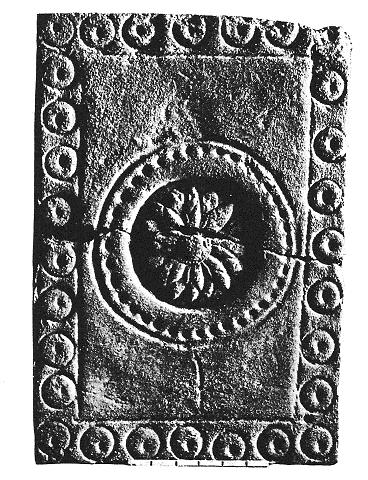
Fig. 1. After: Kak, 1933: pl. XL fig. 43.
A date as late as possible would fit better for Harwan, as, in the past, a chronology was proposed that was obviously too early, thus rendering impossible the presence of the (Iranian) pearl roundels pattern (Kak, 1933: pls. XX, XXII.1, XXII.3, XXX.22, XXXIV.31, XL.42-43; Fisher, 1987.a). In the most recent study dedicated to Kashmiri art, a date to 5th century is proposed (Paul, 1986: 44), although even the 6th century could also be considered likely: this was the period of invasions from the north-west which have been attributed to the Huṇas by Indian sources.
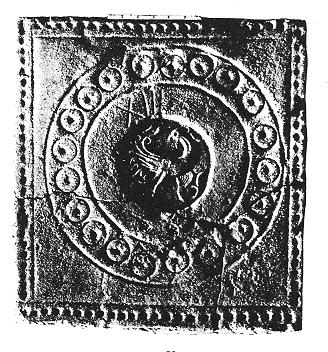
Fig. 2. After: Kak, 1933: pl. XXX fig. 22.
Of the Huṇas much needs to be discovered (Parlato, 1990; De La Vaissière, 2003) but it is not possible to deny that the invaders of North-Western India could have brought Iranian elements although their affiliation was to a different ethnic group (for example, even Altaic). In any case, it is worth remembering that pearl roundels containing single lotus flowers appeared around 1st century in Indian art at Bharut (?) and Sañci (Bénisti, 1952). So, a pure Indian component should be taken into consideration when studying the Harwan tiles.
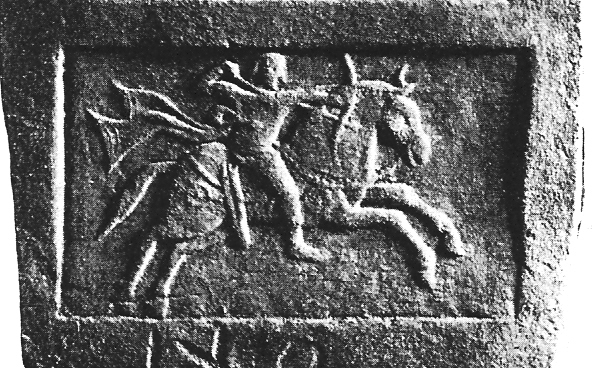
Fig. 3. After: Kak, 1933: pl. XXXIII fig. 3 (detail).
On the other hand, the pearl roundels reproduced on the pillows on which two bronze statuettes of Buddha are sitting in maradhāsanamudrā and dharmacakramudrā can not be considered proper Sasanian despite the hypotheses expressed by some scholars who consider such an element indisputably Sasanian (Tucci, 1974: 300). The statuettes are kept respectively in the Norton Simon Museum (fig. 4) and the Lahore Museum (fig. 5) and they can be dated quite precisely to 8th century Kaśmīr (Pal, 1975: cat. 22.a-b; Catalogue Naples, 1964: cat. 329).
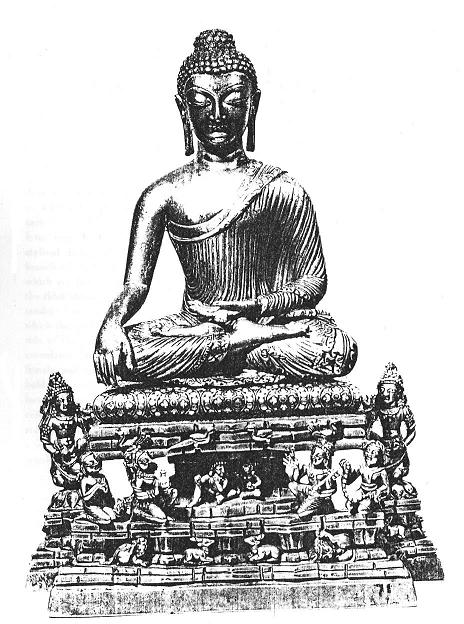
Fig. 4. After: Pal, 1975: cat. 22.a.
The vegetal elements represented inside the pearl roundels have a very precise parallel in the figurative textiles found around Turfan (Gao, 1986: 129, fig. 91 and 161, fig. 76). Although it is not clear if these textiles were actually produced in the area of Turfan or in the region of Shu (modern Sichuan Province), the presence of Sogdians at both Chinese sites represents an historical fact (Compareti, 2006). A third 8th century metal statuette recently showed on the occasion of an exhibition in Germany could be included in this group: it is possible to observe a Buddha in dharmacakramudrā sitting on a pillow on a high pedestal wonderfully embellished (Catalogue Berlin, 2006: cat. 11). It was kept in the Potala in Lhasa and its state of preservation is excellent: traces of color can be clearly observed on the whole statue especially on the face and hair of Buddha and on the pillow embellished with pearl roundels of the same kind of the two other metal statuette in the Norton Simon Museum and the Lahore Museum.
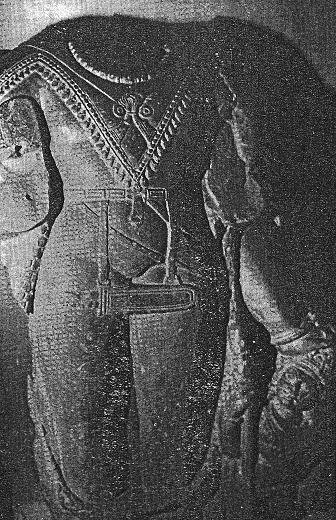
Fig. 5. After: Catalogue Naples, 1964: cat. 329.
One last 8th century Kashmiri bronze with silver and copper inlay, now part of a private collection, presents interesting decorations too (Heller, 2006: figs. 125-129). The sitting Buddha in dharmacakramudrā is curiously dressed with precious clothes, a pointed crown and ribbons while at his sides stand two bodhisattvas and, below, three smaller donors. Pearl roundels embellish the frontal side of the pillow on which the Buddha is sitting and the garments of one donor, although the latter is only partially visible (fig. 6). A very important detail of this statue is the three-pointed camail on Buddha’s shoulders. In fact, usually, just bodhisattvas and minor Buddhist deities have such precious garments since they are not supposed to have done any renunciation. This kind of small cloak reflects the fashion of the people living in the North-Western Indian regions and in the territory of modern Afghanistan and, sometimes, it can be observed worn by Buddha himself according to the typology called “Buddha parée” (Compareti, 2007).
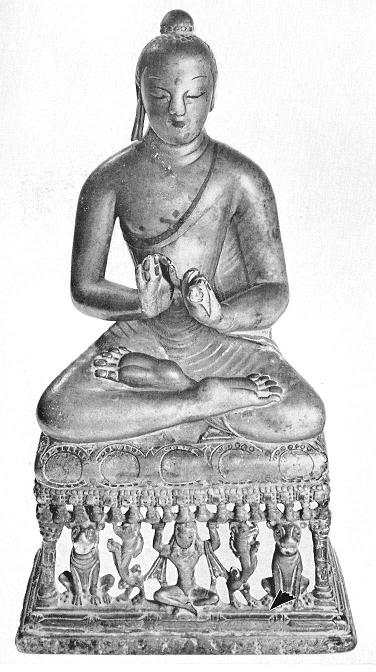
Fig. 6. After: Heller, 2006: fig. 126 (detail).
A typical Iranian dress, the camail, can be observed often in Kashmiri statues of Sūrya as, for example, at Martand, in the Lahore Museum (fig. 7), in the Srinagar Museum and in several bronze statues kept in museums and private collections (Goetz, 1969: pl. XXI; Fisher, 1987.b: fig. 7; Siudmak, 1987: 51; Harle, 1987; Pal, 1992: figs. 3, 6-7). The camail is a three-pointed poncho-like cloak worn over the other clothes. Figures of donors wearing the camail can be observed in Gandhāran statues but also, later, in Sogdian paintings from Panjakand (Marshak, 2002: fig. 60). According to J. Siudmak, the camail would have been introduced into Kaśmīr during the Kārkoṭa Dynasty, possibly, by the Buddhist communities protected by Lalitāditya (Siudmak, 1987: 51). One of Lalitāditya’s ministers, in fact, was a Tokharian and a patron of Buddhist works too. His name was Cankuna, possibly a corruption of the Chinese title jiangjun (general), and, most likely, he was a follower of the Dharma (Goetz, 1969.a: 11-12). This figure as well has been critically reconsidered by Tansen Sen and, if his suggestions (as it seems likely) are to be considered correct, then Cankuna should be considered to have come from Bactria-Tokharistān and not from the region of the Tarim Basin as supposed by H. Goetz (Sen, 2004: 151-152). Since in all the territories just mentioned the pearl roundels pattern was very well-known and appreciated, it was proposed to attribute to Cankuna its introduction into Kaśmīr (von Schroeder, 1981: 107). The hypothesis seems to be likely but it is not clear if Cankuna himself adopted particular decorations directly from Sasanian or Sogdian traditions. The second hypothesis would seem more convincing since, in the 8th century, the Sasanians did not exist anymore.
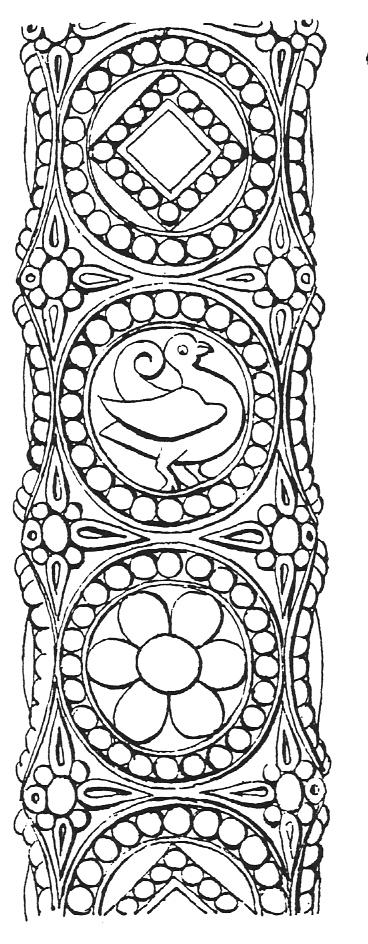 Fig. 7. After: Pal, 1992: fig. 6.
Fig. 7. After: Pal, 1992: fig. 6.
Architectonic decoration under the Kārkoṭas show Iranian elements as well. The Śiva stone temple at Pandrethan has the ceiling embellished by large pearl roundels containing lotus flowers of the same kind of the Harwan ones (Brown, 1955: 48; Fisher, 1987.b: fig. 9, 14). The same shape of the ceiling has a clear parallel in the so-called “lantern” typology which was very widespread in Central Asia such as at Varakhša and Qal‘a-e Qahqaha (but also in the Caucasus). Strangely enough, pearl roundels do not appear at Mārtand.
After the death of Lalitāditya, the Kārkoṭa Dynasty lasted one century more although the territorial boundaries and the splendor of the court were not the same. The Utpalas did not favor Buddhism as their predecessors. Such a situation mirrors a general trend of the whole of India with the exception of the Bengala region. In the Utpala tributary territory of the Hindū Śahī (c. 843-1026)3, between modern South-Western Afghanistan and Northern Pakistan, Hinduism was the main religion too, as the same dynastic name of those sovereigns points out. Hindu sovereigns were not always tolerant with other religions spread in India which, during some periods, suffered persecutions (Verardi, 2002; Verardi, 2003; Verardi, Paparatti, 2004: 97-102). Among the few protectors of Buddhism in Central Asia there was Tang China that was present in the area until 750. This is considered to be the main reason for the sinicized features of the face of Buddhist statues on a great area extended from the borders with China to Margiana (Rhie, 1988; Verardi, Visconti, forthcoming). Kaśmīr does not seem to constitute an exception and, in fact, the famous Kashmiri Buddhist bronzes display very strong mongolic traits such as almond eyes (Goetz, 1955: 72; Heller, 2008: 30).
The Rājataraṅgiṇī is not too explicit about the material presence of Iranians in the territory of Kaśmīr although the decoration of some temples in the area of Śrinagar shows evident signs of Iranian borrowings. The temple of Avantisvāmi (or Avantiśvāra) in Vantipur has columns embellished with vertical pearl roundels containing animal, vegetal and geometric elements. The repertoire at Avantisvāmi is very rich: here, in fact, all the typology of pearl roundels just described can be observed (fig. 8). The roundels at Avantisvāmi also present square elements in the points where they should have been tangent to another roundel. This is a typical solution observed in Sasanian stuccoes and, occasionally, textiles, while in Sogdian textile art it is much more widespread (Compareti, 2004.a). Certainly, many Persians escaped from the Arabs who invaded the Sasanian Empire and it is also probable that they settled in some parts of India and Central Asia4. As it is well-known, typical Sasanian motifs were accepted by the Omayyads (661-750) and the Abbasids (750-1268) but it is very strange to observe them in Kaśmīr during the Utpala period, that is to say, approximately two centuries after the end of the Sasanians. Moreover, the decorations of the Avantisvāmi temple comprehend images of facing animals also which were not appreciated at the Sasanian court (Compareti, 2000: 338-339)5. On the contrary, facing animals represent the main subject inside the pearl roundels of the textiles improperly called zandaniji, which were woven in a non-determined region of Central Asia after the Arab conquest (Marshak, 2006.a; Raspopova, 2006). So, it seems more probable that the Iranian motifs adopted in the decoration of the Utpala temples were coming from Central Asia and not from Sasanian Persia.
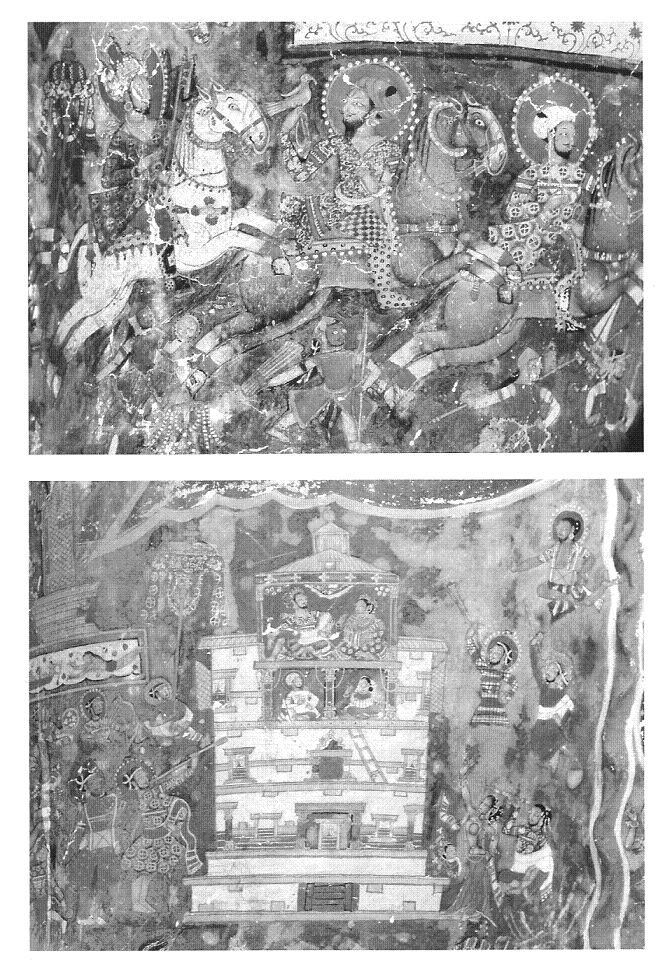
Fig. 8. After: Kak, 1933: LXXXII.
At the time of the Kārkoṭas and the Utpalas and even later, at least until 12th-13th centuries, Kashmiri art deeply influenced the entire Himalayan region (Pal, 1987; Siudmak, 2000; Henss, 2002; Béguin, 2002: 246-247; Heller, 2008: 28-30). Most likely, Iranian elements observed in the artistic production of Tibet arrived there through Kashmiri artists. Not only central Tibet but also Ladakh and Guge – that is to say, the western outskirts of the Tibetan Empire – accepted many Iranian elements especially in the decoration of the garments of Bodhisattvas and, quite strangely, Buddha too. The main Buddhist centers of Ladakh are represented by the monasteries of Mangyu and Alchi, dated to 12th-13th century (Pal, 1988; Linrothe, 1994; Goepper, 1996). The latter site is particularly interesting for the presence of pearl roundels reproduced on the ceiling of the Sumtsek (gSum-brtsegs), a three-storied temple built in early 13th century (fig. 9). Many patterns of pearl roundels can be observed and scholars agree in recognizing not only Iranian motifs but also painted imitations of textiles (Flood, 1991; Goepper, 1993; Goepper, 1996: 225-264). The same decorations which embellish the garments of important people in the paintings at Alchi display clear Iranian borrowings: and also for them a Sogdian origin can be argued (Singh, 1991: 517; Sims, 2002: 23-24; Pal, 2007: 147-149). Very recently, new Tibetan paintings have been discovered in the region of the ancient kingdom of Guge which is nowadays under Chinese administration too. According to the preliminary investigations, there are clear Kashmiri borrowings in those paintings which could be dated between 11th-15th/16th century (The Institute of Chinese Tibetan Learning of Sichuan University, 2007: figs. 10-13, 21-24; Pritzker, 2008).
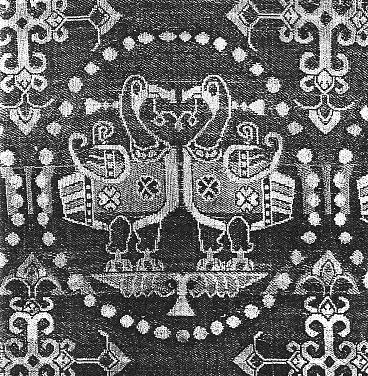
Fig. 9. After: Flood, 1991: fig. 3.
Something more could be added about the paintings on the dhotī of the bodhisattva Avalokiteśvara on the ground floor of the Sumtsek at Alchi. Approximately in its center, slightly above the knees of the statue, two scenes attracted the attention of scholars for two reasons: they are the only ones not to be interpreted as religious scenes and “clearly reflect stylistic elements that are different from the earlier Buddhist paintings of the eleventh-century monuments. They evoke a cultural milieu that was both sophisticated and cosmopolitan” (Pal, 2007: 147). On the right leg a royal couple sits in a palace while musicians and attendants can be observed outside on both sides. On the left leg there is the representation of a parade of horsemen and the king appears too holding clear royal symbols like the axe (fig. 10). Not only some of the textile decorations could be associated to the Iranian world but the royal scene itself calls to mind similar Islamic book illustrations which could be contemporary with the paintings in Alchi.
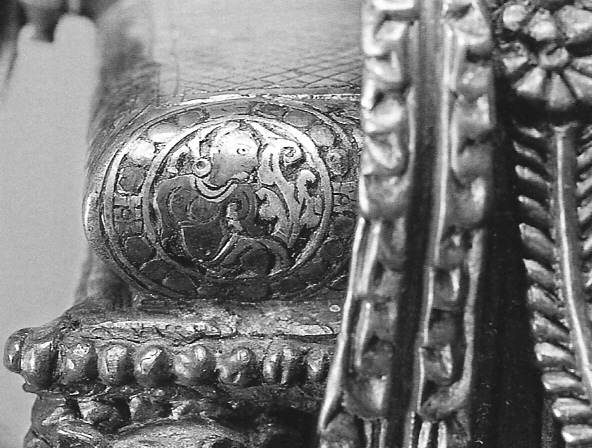
Fig. 10. After: Pal, 2007: fig. 157.a-b.
Many specimens of Islamic book illustration could be mentioned in order to find a parallel with the Alchi paintings under exam but there is a frontispiece in the Topkapı Saray (Istanbul) known as Hazine 2125 which resembles surviving parts of an important 7th century cycle of Sogdian paintings at Afrāsyāb (ancient Samarkand) whose origins are definitely rooted in pre-Islamic traditions of Central Asian art (Esin, 1977; Pugačenkova, 1987). As I attempted to prove in another paper, at least at Afrāsyāb there is the representation of the local Nawrūz (the most important Iranian festival) while in the Topkapı and in many other Islamic book illustrations it is not possible to be that specific: what is really important to remark is the common origins of such a stereotyped scene despite its meaning which could be different according to the cultural milieu where it is found (Compareti, forthcoming 2009). Musicians appear always in this group of images together with dancers and attendants offering a flower (or a plant), a bow with arrows, and also horses and other animals used for hunting (dogs and falcons) to the king or the royal couple (fig. 11)6. Something similar could be guessed for Alchi itself. In fact, even if we do not know the exact meaning of that royal scene it is interesting to note that the Kashmiri artists who executed it chose an Iranian model which was spread for a very long time and accepted also by other Central Asian peoples like Turks and Mongols.
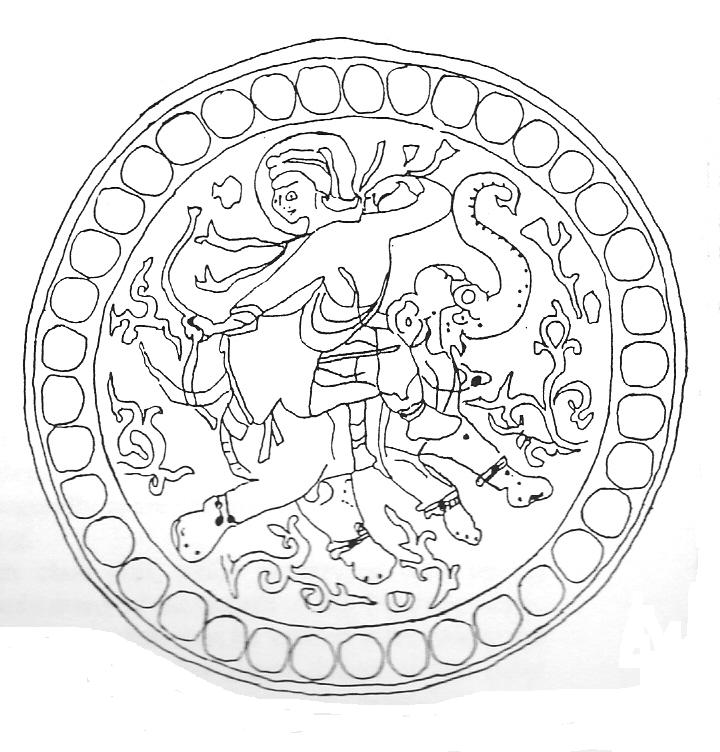
Fig. 11. After: Compareti, forthcoming 2009: figs. 4-5.
In Ladakh some Sogdian inscriptions have been discovered too. They cannot be dated precisely but, while the 4th-6th century inscriptions do not represent an unicum since there are other contemporary ones in the Hindus Valley (Sims-Williams, 1989-1992), the 9th century inscription, on the contrary, is among the latest evidence concerning the presence of Sogdians along the Himalyan trade routes (Sims-Williams, 1993; Vohra, 1994).
The main monuments in the territory of Guge (which is nowadays divided between India and China) are: the monastery of Tabo and the grottoes of Dung dkar, both dated to the 11th century (Wandl, 1999; Neumann, 2000). The paintings from Tabo are definitely the most interesting and they were rightly associated with the paintings at Bāmyān for their numerous Iranian decorative elements (Klimburg-Salter, 1996). A unique group of manuscript covers from the area of Gilgit possibly dated to 7th-8th century constitutes another parallel with paintings produced in the areas of modern Afghanistan where Iranian Buddhism was spread. Not only are the figures of Buddha and Bodhisattvas on these covers extremely similar to the models at Bāmyān, Kakrak and Fondukistān but the features of the donors represented kneeling besides them also have clearly common roots (Klimburg-Salter, 1990; Klimburg-Salter, 1991).
2.1. Tibet under the Yarlung
During the period of the Yarlung Dynasty, Tibet was one of the main powers in Central Asia and the contacts with the Sogdians are attested in several sources. The Tibetans extended their conquests on the Tarim Basin between 666-692 and, more firmly, between 760-850. They also conquered some parts of Gansu (Haarh, 1969; Beckwith, 1987; Hoffmann, 1990). Until a first attempt of establishing good relationships with the Omayyads and, later, the Abbasids (Dunlop, 1973), the btsanpo Khri lde gtsug brtsan (712-755) – one of whose wives was a princess from Samarkand (Twitchett, 1979: 432) – fought against the Arabs together with his Turkic allies in order to expel them from Sogdiana (Beckwith, 1987: 108-110). It is not completely clear what was the reason for such an intervention. Possibly the Sogdian traders represented a good source of gain for the Tibetans who controlled the access to some vital routes in Central Asia. The relationships between Sogdiana and Tibet were in general friendly (Li, 1957-58; Hoffman, 1971; Uray, 1979: 282-283; De La Vaissière, 2002: 152-153), even though it is reported that there was at least one episode of an incident when a Tibetan official was captured by some Sogdians in 694 (Li, 1957-58; Hoffman, 1971: 443-446; Beckwith, 1987: 56).
The Yarlung conquest of Khotan – an Iranian Buddhist kingdom in strict relations with Kaśmīr and Sogdiana (Bailey, 1982: 4, 9, 57: Kumamoto, 1996: 84-86; Mu, Wang, 1996) – heralded the immigration of many Khotanese monks, craftsmen and merchants into Tibet (Hofmann, 1971: 451-453; Gropp, 1974: 36-37). A Kashmiri bronze statue is said to have been found at the site of Domoko, in the Khotan Oasis (Heller, 2006: 185, n. 25; Heller, 2008: fig. 11). The word for merchant in Khotanese was sūlī (plural sūlya, sūlīya) and, although it is probably connected with an Iranian root sau– (to earn), most likely, it is also associated to the ethnonym sūlya: Sogdian. This is probably due to the fact that the Sogdians were considered the merchants par excellence in Central Asia (Bailey, 1982: 23; De La Vaissière, 2002: 64, 130).
The Sogdians had trade relationships with Tibet (Beckwith, 1965: 100-103: De La Vaissière, 2002: 303). Since the main items traded by Sogdians were luxury goods, it is possible to consider that they imported into Tibet precious silks and metalwork. The court of Lhasa, on the other hand, provided the Sogdians with the famous perfumed musk which was very much requested by the Muslim courts. According to Mas’udi (10th century), some merchants that he met in Eastern Persia arrived there “from Sogdiana through
2.2. Iranian elements in Tibet
The archaeological investigation confirmed the reciprocal knowledge of the Sogdians and the Tibetans7. Several textiles and metalwork embellished with motifs, very common in Sogdian art, have been recovered from the cemetery of Dulan, not far from Reshui in Qinghai Province, which can be dated to 8th-9th century (Heller, 1998.a; Heller, 1999; Heller, 2003.a; Heller, 2006). This region was known as Amdo and, in that period, it was part of the Tibetan Empire. Also the funerary habits of the princely tombs at Dulan reveal connections with Tibet.
Other textiles from Tibet appeared in the antiquary market and form important collections in museums around the world. A child’s jacket embellished with pearl roundels containing confronted ducks (fig. 12) constitutes an exact parallel with the so-called zandaniji textiles and with some silk fragments from Dulan (Catalogue New York, 1997: 34-37; Heller, 1998.b).
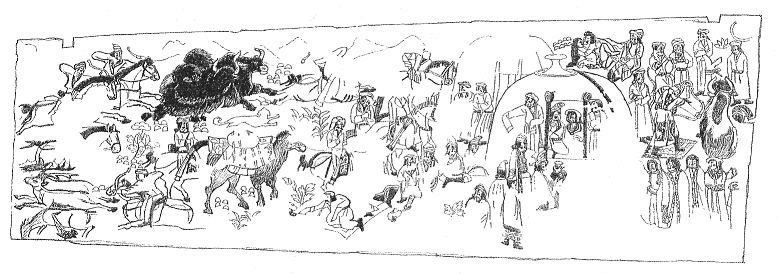
Fig. 12. After: Catalogue New York, 1997: cat. 5.
A unique silk fragment from Dulan presents a very interesting inscription in Pahlavi, the language used by the Sasanians for their official inscriptions. This fragment represents the only unquestionable evidence of the relationships between Persia and Tibet although the possibility can not be ruled out that it was written by a person who was not a Persian but knew Pahlavi. For example, Manichaeans who lived in the territory around Turfan (for long periods even under Tibetan control) continued to use Pahlavi after the fall of the Sasanian Empire (Tremblay, 2001: 220-238). Also Sasanian silver coins have been found in the cemetery of Dulan (Heller, 2008: 16-18) although they could have been imported by Sogdians who, very often, used Persian coins of the reign of Peroz (459-484) after countermarking them even with typical Sasanian symbols (Nikitin, Roth, 1995).
As it is well-known, many Persians escaped from the Arab conquest of the Sasanian Empire and epigraphic traces of their presence are found in Sogdiana at Panjakand and Paykand (Raspopova, 1990: fig. 26; Semenov, Mirzaahmedov, 2001: 9), in China at Chang’an on a 9th century funerary stele which belonged to Māhšī Sūrēn (Harmatta, 1971) and, more recently, at Dulan8. For this reason, A. Nikitin proposed a very interesting hypothesis about the rise of Tibet as a “world power” during 7th century. According to him, the arrival of Iranians at Lhasa gave a great impulse to the development and organization of the Tibetan military power which in a few years constituted a menace for China, the Uighurs and the Arabs9. One of the main technological resources of the Tibetans, in fact, was the production of chain mail for armor. At least one Chinese source describes Tibetan warriors and horses as completely clad in armor, so that only the eyes were not protected (Beckwith, 1987: 110). This description, actually, calls to mind the (late) Sasanian relief of one equestrian knight completely clad in armor in the bigger grotto at Ṭāq-e Bostān which represents, however, a unique and enigmatic specimen of sculpture in the whole of pre-Islamic Persian art (Fukai, Horiuchi, 1972).
Even if the interesting suggestion by Nikitin is accepted, there are only the Pahlavi inscription from Dulan and few coins to support a conspicuous presence of Persians at the court of Lhasa so, for the moment, it is not possible to be more specific. Little other evidence could be enlisted about the Tibetan-Persian relationships. According to a stone tablet inscribed in Chinese and said to be kept in Tokyo, a Christian official of Persian origin called Aluohan was at the head of some Tibetan tribes that he tried to convert between 656 and 661 (Dauvillier, 1950: 218). It is not clear if this is the same Aluohan who was in the service of the Tang Dynasty in 7th century and who was possibly one of the sons of the last Sasanian king Yazdigard III (632-651) (Forte, 1996.a)10. In late Sasanian Persia, Christians had very important positions and it is not excluded that Yazdigard III and Peroz (another of his sons) had many connections with them (Compareti, 2003: 207-208). Other Chinese literary sources state that in 677 Peroz requested the Chinese Emperor for permission to build a “Persian temple” in Chang’an which was, most likely, a Christian and not a Mazdean building (Forte, 1996.b: 355, 364).
However, Zoroastrianism continued to be the creed of the Iranians and especially the Persians. Common elements in Zoroastrian literature and in Tantric religion have been considered to be a trait borrowed by Tibetans from Iranian lands (Templeman, 2002).
The tombs belonged to people who were in very strict contact with Tibet like those under excavation in Guolimu, Haixi (Qinghai) revealed also 9th century painted coffins embellished with very interesting scenes (Luo, 2006). The main subject is the hunt which is represented according to formulae very spread on a very big area, practically in the whole Eurasian continent. In the case of the Guolimu coffin it is possible to observe at least one hunter shooting a couple of running yaks in the position of the so-called “Parthian shot” (fig. 13). In the same painting there is also a deer hunt and a scene which could be interpreted as a banquet in front of a tent.
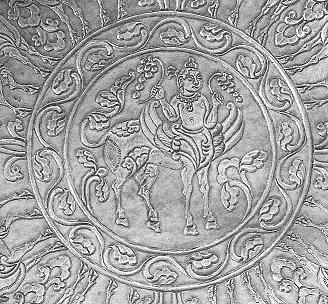
Fig. 13. After: Luo, 2006: 1 (detail).
According to B. Maršak, a silver gilt dish kept in the Miho Museum (Shigaraki, Japan) embellished with fantastic creatures should be attributed to 8th-9th century Tibet (Catalogue Wien, 1999: cat. 49; Heller, 2003.b: 228-229). Very strong Iranian elements can be observed on the body of the central centaur and on the bodies of the winged couples of animals along the external rim of the dish (fig. 14). These elements reproduce vegetal or geometric motifs typical of Sogdian textiles and metalwork (Compareti, 2004.b: 874-882). Mushroom-like horns can be observed on the head of some of the winged deer, according to a scheme similarly developed in Sogdian metalwork (Maršak, 1971: T29, T 37). Iranian traditions seem to be evident in Himalayan metalwork production just because importations from Sasanian Persia were very common throughout the Eurasian continent. As recent investigations would support, it is very likely that Sasanian sovereigns used luxury objects like textiles and metalwork as the main goods to be exchanged with neighboring kingdoms. Persian metalwork and textiles have been found in the tombs of important people from the Urals to Japan, and it is highly probable that the same Tang emperors adopted the habit to present diplomatic gifts according to the “Western” iconography because of the contacts with Sasanians and Sogdians (Compareti, 2000). A silver bowl embellished with Greek themes found in Tibet which has been considered to be Persian (Denwood, 1973) could be easily a metalwork produced in Bactria-Tokharistan where Hellenistic borrowings have been always stronger than in Iran and in other regions of Central Asia.
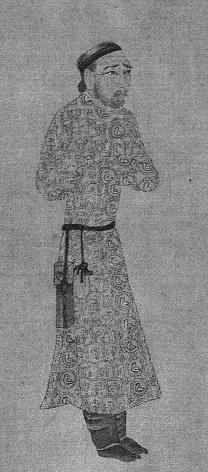
Fig. 14. After: Catalogue Wien, 1999: cat. 49 (detail).
An 8th century silver jar kept in Lhasa depicts the head of a mushroom-like-antler deer on its top, while the body of the jar is embellished with representations of Iranian people, most likely Sogdians dancing and drinking (Heller, 2003.b). Sogdian metalwork would have been highly esteemed in Tibet and, in fact, evidence of such an influence can be noted in several Tibetan specimens found at different archaeological sites (Heller, 2003.a; Heller, 2003.b).
The most important evidence of the real use (or, at least, of the knowledge) of garments embellished with Iranian motifs by the Tibetan high classes is preserved in Chinese art. A scroll representing the Chinese Emperors painted by the famous artist Yan Liben (c. 600-674) shows also a Tibetan envoy wearing a caftan embellished with single birds within pearl roundels (fig. 15). The scene possibly refers to an episode which actually happened in 640, when the Tibetan minister mGar sTon btsan yul zun arrived in Chang’an in order to escort to Lhasa the Chinese princess Wencheng Gongzhu who was promised to his king, Srong btsan sgam po (c. 610-649) (Karmay, 1975; Karmay, 1977). The detailed rendering of the “barbaric” garments of mGar evidently attracted the attention of Yan Liben who probably saw with his own eyes the Tibetan embassy. However, Chinese literary sources say that silk started to be adopted by Tibetans only after the wedding of Srong btsan sgam po with Wencheng Gongzhu (Richardson, 1975). So, the caftan worn by mGar could have been a gift of the Tang Emperor although the possibility that Tibetans already knew precious textiles cannot be ruled out. A different interpretation could be given in order to identify that person. Recently, it was proposed to recognize him as a foreigner, specifically a Sogdian, who worked for the Tibetans due to his physical features and caftan (Heller, 2003.b: 223, 231). Sogdians from different social classes and, particularly, merchants worked at the Chinese courts between 4th-9th century as translators as well.
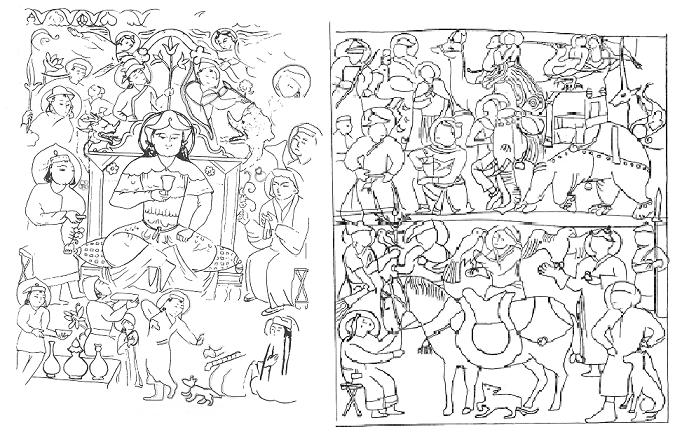
Fig. 15. After: 5000 ans d’art chinois. Peinture 2. La peinture sous les Sui, les Tang et les Cinq Dynasties, ed. Jin Weinuo, Beijing, Bruxelles, 1988: fig. 2a, p. 232.
Possibly, the Sogdian traders brought silk into Tibet. The pearl roundels on the garment of Yan Liben’s “Tibetan” envoy, in fact, present single birds of the same kind observed in Sogdian paintings at Afrāsyāb, Panjakand and Varakhša. The hypotheses expressed about the painting by Yan Liben consider the caftan worn by the envoy as a silk product as a matter of fact although it could have been, for example, also a woolen garment, or another warm textile more attuned to the weather of Tibet.
The sources and the archaeological evidence considered above point out at a situation just partially investigated11. Nevertheless, it is possible to state that the Sogdians were much more present in Kaśmīr and Tibet than the Persians unless the first studies dedicated to the Iranian elements in the Himalayan regions favored the Sasanians.
Further investigations could shed light on the hypothesis about a strong Iranian presence in Tibet after the unification of the country in the middle of 7th century and an improving of technical and military knowledge, something which would require an approach from the point of view of specialists not only in the field of Iranian studies but Tibetan too.
Literature
H. W. Bailey, The Culture of the Sakas in Ancient Iranian Khotan, New York, 1982.
C. I. Beckwith, “Tibet and Early Medieval Florissance in Eurasia. A Preliminary Note on the Economic History of the Tibetan Empire”, Central Asiatic Journal, vol. XXI, 2, 1965: 89-104.
C. I. Beckwith, The Tibetan Empire in Central Asia: a History of the Struggle for Great Power among Tibetans, Turks, Arabs, and Chinese During the Early Middle Ages, Princeton, 1987.
G. Béguin, “Il Tibet e la Mongolia”, in: Le arti dell’Asia centrale, ed. P. Chuvin, Milano, 2002: 242-325 (Italian translation of Les arts de l’Asie centrale, Paris, 1999).
M. Bénisti, Le médaillon lotiforme dans la sculpture indienne du IIIe siècle avant J.-C. au VIIe sciècle après J.-C., Paris, 1952.
P. Brown, “The Architecture of Kashmir (Hindu and Buddhist)”, Marg, vol. VIII, 2, 1955: 40-52.
Catalogue Berlin, 2006: Tibet. Klöster offnenn ihre Schatzkammern, B. Beitz (curator), Berlin, 2006.
Catalogue Naples, 1964: 5000 anni d’arte in Pakistan, M. Bussagli (curator), Naples, 1964.
Catalogue New York, 1997: When Silk was Gold. Central Asian and Chinese Textiles, A. E. Wardwell, J. C. Y. Watt (curators), New York, 1997.
Catalogue New York, 2004: China. Dawn of the Golden Age, 200-750 AD, J. C. Y. Watt (curator), New York, 2004.
Catalogue Wien, 1999: Schätze des Orients. Meisterwerke aus dem Miho Museum, W. Seipel (curator), Wien, 1999.
E. Chavannes, Documents sur les Tou-Kieu (Turks) Occidentaux, Paris, 1903.
M. Compareti, “Iranian Divinities in the Decoration of Some Dulan and Astana Silks”, Annali di Ca’ Foscari, XXXIX, 3, 2000: 331-368.
M. Compareti, “The Last Sasanians in China”, Eurasian Studies, II, 2, 2003: 197-213.
M. Compareti, “The Sasanian and the Sogdian «Pearl Roundel» Design: Remarks on an Iranian Decorative Pattern”, The Study of Art History, 6, 2004.a: 259-272.
M. Compareti, “Evidence of Mutual Exchange between Byzantine e Sogdian Art”, in: La Persia e Bisanzio, Roma, 2004.b: 865-922.
M. Compareti, “The Role of the Sogdian Colonies in the Diffusion of the Pearl Roundel Design”, in: Ērān ud Anērān. Studies Presented to B. I. Maršak on the Occasion of His 70th Birthday, eds. M. Compareti, P. Raffetta, G. Scarcia, Venezia, 2006: 149-174.
M. Compareti, “Some Specimens of Central Asian Decorative Elements in Ajaṇṭā and Bāgh Paintings”, The Study of Art History, 9, 2007: 461-472 (in Chinese).
M. Compareti, “Coronation and Nawruz: A Note on the Reconstruction of the Missing King at Afrāsyāb”, in: Sogdians at Home and Abroad. Papers in Honour of Boris I. Maršak 75th Birthday, ed. A. Torgoev, St.Petersburg, forthcoming 2009.
S. Cristoforetti, “Le nawrūzī selon le Nawrūz–nāma“, Eurasian Studies, VI, 2007-2008: 71-95.
A. H. Dani, “Eastern Kushans, Kidarites in Gandhara and Kashmir, and Late Hephtalites. Part One. Estern Kushans and Kidarites in Gandhara and Kashmir”, in: History of Civilizations of Central Asia. Vol. III. The Crossroads of Civilizations: A.D. 250 to 750, ed. B. A. Litvinsky, Paris, 1996: 163-176.
J. Dauvillier, “L’expansion de l’église chaldéenne au Moyen Âge et le problème des rapports du bouddhisme et du christianisme”, Bulletin de l’Université et de l’Académie de Toulouse, 75, 1950 : 218-221.
Ph. Denwood, “A Greek Bowl from Tibet”, Iran, XI, 1973: 121-127.
D. M. Dunlop, “Arab Relations with Tibet in the 8th and Early 9th Centuries A.D.”, İslam Tetkikleri Enstitüsü Dergisi, V, 1-4, 1973: 301-318.
E. Esin, “A Pair of Manuscripts from the Miscellany Collection of Topkapı”, Central Asiatic Journal, XXI/1, 1977: 13-35.
R. E. Fisher, “The Enigma of Harwan”, Marg, XL, 2, 1987.a: 1-16.
R. E. Fisher, “Stone Temples”, Marg, XL, 2, 1987.b: 29-40.
F. B. Flood, “Mobility and Mutation: Iranian Hunting Themes in the murals of Alchi, Western Himalayas”, South Asian Studies, 7, 1991: 21-35.
A. Forte, “On the Identity of Aluohan (616-710) a Persian Aristocrat at the Chinese Court”, in: La Persia e l’Asia Centrale da Alessandro al X secolo, Roma, 1996.a: 187-197.
A. Forte, “The Edict of 638 Allowing the Diffusion of Christianity in China”, in: P.Pelliot, L’inscription nestorienne se Si-Ngan-Fou, ed. A. Forte, Kyoto, Paris, 1996.b: 348-374.
Sh. Fukai, K. Horiuchi, Taq-i Bustan. II. Plates, Tokyo, 1972.
Gao Hanyu, Textile Decoration During the Past Chinese Dynasties, Hong Kong, 1986 (in Chinese).
R. Ghirshman, Iran. Parthes et Sassanides, Paris, 1962.
L. Giles, “A Chinese Geographical Text of the Ninth Century”, Bulletin of the School of Oriental Studies, VI, 1930-1932: 825-846.
R. Goepper, “Early Kashmiri Textiles? Painted Ceilings in Alchi”, Transaction of the Ceramic Society, 56, 1993: 47-74.
R. Goepper, Alci. Il santuario nascosto del Ladakh. Il Sumtsek, Milano, 1996.
H. Goetz, “The Mediaeval Sculpture of Kashmir”, Mārg, VIII, 2, 1955: 65-75.
H. Goetz, “The Conquest of Northern and Western India by Lalitāditya Muktāpīḍa of Kashmīr”, in: H. Goetz, Studies in the History and Art of Kashmir and the Indian Himalaya, Wiesbaden, 1969.a: 8-22.
H. Goetz, “The Sun Temple of Martand and the Art of Lalitaditya-Muktapida”, in: H. Goetz, Studies in the History and Art of Kashmir and the Indian Himalaya, Wiesbaden, 1969.b: 23-36.
H. Goetz, “The Mediaeval Sculpture of Kashmir”, in: H. Goetz, Studies in the History and Art of Kashmir and the Indian Himalaya, Wiesbaden, 1969.c: 68-76.
F. Grenet, “Mithra, dieu iranien : nouvelles données”, TOΠOI, 11/1, 2001: 35-58.
F. Grenet, “What Was the Afrasiab Paintings About ?”, in: >Royal Nawrūz in Samarkand. Acts of the Conference held in Venice on the Pre-Islamic Afrāsyāb> Painting, M. Compareti, É. De La Vaissière eds., Suppl. n. 1, Rivista degli Studi Orientali, LXXVIII, Roma, 2006: 43-58.
G. Gropp, Archäologische Funde aus Khotan, Chinesisch-Ostturkestan: die Trinkler-Sammlung im Übersee-Museum Bremen, Bremen, 1974.
E. Haarh, The Yar-lun Dynasty. A Study with Particular Regard to the Contribution by Myths and Legends to the History of Ancient Tibet and the Origin and Nature of Ist Kings, Copenhagen, 1969.
J. C. Harle, “Some Foreign Elements of Costume and Hair-Style in Indian Art”, in: Orientalia Iosephii Tucci Memoriae Dicata, vol. II, ed. G. Gnoli, L. Lanciotti, Roma, 1987: 569-572.
J. Harmatta, “The Middle Persian-Chinese Bilingual Inscription from Hsian and the Chinese Sāsānian Relations”, in: La Persia nel Medioevo, Roma, 1971: 363-376.
A. Heller, “Some Preliminary Remarks on the Excavations at Dulan”, Orientations, 29, 9, 1998.a: 84-92.
A. Heller, “An Eighth Century Child’s Garment of Sogdian and Chinese Silk”, in: Chinese and Central Asian Textiles. Selected Articles from Orientations 1983-1997, Hong Kong, 1998.b: 220-222.
A. Heller, Arte tibetana. Sviluppo della spiritualità e dell’arte in Tibet dal 600 al 2000 d.C., Milano, 1999.
A. Heller, “Archaeological Artefacts from the Tibetan Empire in Central Asia”, Orientations, vol. 34, 4, 2003.a: 55-64.
A. Heller, “The Silver Jug of the Lhasa Jokhang: Some Observations on Silver Objects and Costumes from the Tibetan Empire (7th-9th Century)”, Silk Road Art and Archaeology, IX, 2003.b: 213-237.
A. Heller, “Recent Findings on Textiles from the Tibetan Empire”, in: Central Asian Textiles and Their Contexts in the Early Middle Ages, Riggisberger Berichte, 9, 2006: 175-188.
A. Heller, Early Himalayan Art, Oxford, 2008.
M. Henss, “Buddhist Metal Images of Western Tibet, ca. 1000-1500 A.D.: Historical Evidence, Stylistic Consideration and Modern Myths”, The Tibet Journal, XXVII, 3-4, 2002: 23-82.
H. H. R. Hoffmann, “The Tibetan Names of the Saka and the Sogdians”, Asiatische Studien, XXV, 1971: 440-455.
H. H. R. Hoffmann, “Early and Medieval Tibet”, in: The Cambridge History of Early Inner Asia, ed. D. Sinor, Cambridge, 1990: 371-399.
The Institute of Chinese Tibetan Learning of Sichuan University et alii, “The Tentative Investigation of Two Buddhist Grotto Sites at Kaepu and Xilingun, Zhada County, Ali Region, Xizang Autonomous Region”, Wenwu, 6, 2007: 49-68.
R. C. Kak, Ancient Monuments of Kashmir, London, 1933.
H. Karmay, “Tibetan Royal Costumes in Dun-Huang Wall-Paintings”, Tibetan Review, Feb-March 1975: 18-19.
H. Karmay, “Tibetan Costume. Seventh to Eleventh Centuries”, in: Essay sur l’art du Tibet, eds. A. Macdonald, Y. Imaeda, Paris, 1977: 64-81.
D. Klimburg-Salter, “The Gilgit Manuscript Covers and the «Cult of the Book»”, in: South Asian Archaeology 1987. Part 2, M. Taddei, P. Callieri eds., Rome, 1990: 815-830.
D. Klimburg-Salter, “Notes on Two Gilgit Manuscript Cover paintings”, in: The Art of Ajanta. New Perspectives. Volume 2, R. Parimoo and alii eds. New Delhi, 1991: 521-535.
D. Klimburg-Salter, “Some Remarks on Canopies in Bāmiyān”, in: La Persia e l’Asia Centrale da Alessandro al X secolo, Roma, 1996: 473-487.
H.-J. Klimkeit, “Vairocana und das Lichtkreuz. Manichäische Elementen in der Kunst von Alchi (West-Tibet)”, Zentralasiatische Studien, 13, 1979: 357-399.
H.-J. Klimkeit, Manichaean Art and Calligraphy, Leiden, 1982.
H. Kumamoyo, “The Khotanese in Dunhuang”, in: Cina e Iran. Da Alessandro Magno alla dinastia Tang, ed. A. Cadonna, L. Lanciotti, Firenze, 1996: 79-101.
É. De La Vaissière, Histoire des merchands sogdiens, Paris, 2002 (reprint 2005).
É. De La Vaissière, “Is There a «Nationality of the Hephtalites»?”, Bulletin of the Asia Institute, 17, 2003: 119-132.
É. De La Vaissière, “Huns et Xiongnu”, Central Asiatic Journal, 49, 1, 2005: 3-26.
É . De La Vaissière, É. Trombert, “Des Chinois et des Hu. Migrations et intégration des Iraniens orientaux en milieu chinois durant le haut Moyen Âge”, Annales. Histoire, Sciences Sociales, 5-6, 2004 : 931-969.
Fang-kuei Li, “Notes on Tibetan Sog”, Central Asiatic Journal, III, 2, 1957-58: 139-142.
S. N. C. Lieu, Manichaeism in Central Asia and China, Leiden, Boston, Köln, 1998.
R. N. Linrothe, “The Murals of Mangyu: a Distillation of Mature Esoteric Buddhist Iconography”, Orientations, 25, 11, 1994: 92-102.
Luo Shiping, “A Research about the Drawing on the Coffin of Tubo Located at Guolimu, Haixi, Qinghai Province”, Wenwu, 7, 2006: 68-82 (in Chinese with an English summary).
B. Maršak, Sogdiskoe serebro. Očerki po vostočnoj torevtike, Moskva, 1971.
B. Marshak, Legends, Tales, and Fables in the Art of Sogdiana, New York, 2002.
B. I. Marshak, “The So-Called Zandanījī Silks: Comparisons with the Art of Sogdia”, in: Central Asian Textiles and Their Contexts in the Early Middle Ages, Riggisberger Berichte, 9, 2006.a: 49-60.
B. I. Marshak, “Une peinture kouchane sur toile (suivi d’une note additionelle par F. Grenet)”, Comptes Rendus de l’Académie des Inscriptions et Belles-Lettres, II, 2006.b: 947-963.
Mu Shun-ying, Wang Yao, “The Western Regions (Hsi-Yü) Under the T’ang Empire and the Kingdom of Tibet”, in: History of Civilizations of Central Asia. Volume III: The Crossroad of Civilizations: A.D. 250 to 750, ed. B. A. Litvinsky, Paris, 1996: 349-365.
H. F. Neumann, “The 11th Century Wall-Paintings of the Rediscovered Caves of Du.dkar in Western Tibet”, in: South Asian Archaeology 1997, vol. III, ed. M. Taddei, G. De Marco, Rome, 2000: 1383-1402.
A. Nikitin, G. Roth, “A New Seventh-Century Countermark with a Sogdian Inscription”, The Numismatic Chronicle, 155, 1995: 277-279.
P. Pal, Bronzes of Kashmir, New Delhi, 1975.
P. Pal, “Kashmir and the Tibetan Connection”, Marg, vol. XL, 2, 1987: 57-75.
P. Pal, Marvels of Buddhist Art. Alchi-Ladakh, Hong Kong, New York, Paris, New Delhi, 1988.
P. Pal, “Some Unusual Sūrya Images from Kashmir”, Lalit Kalā, 26, 1992: 9-13.
P. Pal, The Arts of Kashmir, Milan, 2007.
A. Panaino, “The Year of the Maga Brāhmaṇa”, in: La Persia e l’Asia Centrale da Alessandro al X secolo, Roma, 1996: 569-587.
S. Parlato, “La presunta invasione eftalita dell’India”, in: Indo-Sino-Tibetica. Studi in Onore di Luciano Petech, ed. P. Daffinà, Roma, 1990: 257-281.
P. G. Paul, Early Sculpture of Kashmir (Before the Middle of the Eigth Century A.D.). An Approach to Art History and Epigraphy of the Jhelum Valley and Its Peripheral Regions, Leiden, 1986.
T. J. Pritzker, “The Wall Paintings of Nyag Lhakhang Kharpo”, Orientations, 39, 2, 2008: 102-112.
G. Pugačenkova, “K diskussi o sredneaziatskoj miniatiure XV stolenija,” in: Iz hudožestvennoj sokroviščnicy Srednego Vostoka, Taškent, 1987: 186-199.
V. I. Raspopova, Žilišča Pendžikenta (opyt istoriko-social’noj interpretacii), Leningrad, 1990.
V. I. Raspopova, “Textiles Represented in Sogdian Murals”, in: Central Asian Textiles and Their Contexts in the Early Middle Ages, Riggisberger Berichte, 9, 2006: 61-73.
A. Rehman, The Last Two Dynasties of the Śāhis. An Analysis of Their History, Coinage and Paleography, Islamabad, 1979.
H. Richardson, “More on Ancient Tibetan Costume”, Tibetan Reviw, My-June 1975: 24 and 15.
M. M. Rhie, “Interrelationships between the Buddhist Art of China and the Art of India and Central Asia from 618-755 A.D.”, Supplement 54, Annali dell’Istituto Universitario Orientale di Napoli, 48, 1, 1988.
J. M. Rosenfield, The Dynastic Art of the Kushans, Berkeley, 1967.
G. L. Semenov, Dž. K. Mirzaahmedov et alii, Raskopki v Pajkende v 2000 godu, Sankt-Peterburg, 2001.
Sen Tansen, “Kaśmīr, Tang China, and Muktāpīḍa Lalitāditya’s Ascendancy Over the Southern Hindukush Region”, Journal of Asian History, 38, 2, 2004: 141-162.
A. M. H. Shboul, Al-Masʻūdī and His World. A Muslim Humanist and His Interests in non-Muslims, London, 1979.
E. Sims, Peerless Images. Persian Painting and Its Sources, New Haven, London, 2002.
N. Sims-Williams, Sogdian and Other Iranian Inscriptions of the Upper-Indus, I-II (Corpus Inscriptionum Iranicarum, part II, vol. II/III/1-2, London, 1989-1992.
N. Sims-Williams, “The Sogdian Inscription of Ladakh”, in: Antiquities of Northern Pakistan. Reports and Studies, vol. 2, ed. K. Jettmar, Mainz, 1993: 151-163.
A. K. Singh, “Wall Paintings from Ladakh and Spiti”, in: The Art of Ajanta. New Perspectives. Volume 2, R. Parimoo and alii eds. New Delhi, 1991: 511-520.
J. Siudmak, “Early Stone and Terracotta Sculpture”, Marg, XL, 2, 1987: 41-56.
J. Siudmak, “The Development of the Classical Buddha Image from Kashmir, and Some Observations on Kashmirian Influence on the Sculpture of West Tibet”, Oriental Art, XLVI, 2, 2000: 36-46.
J. Siudmak, “Religious Architecture”, in: P. Pal, The Arts of Kashmir, Milan, 2007: 44-59.
M. A. Stein, Kalhaṇa’s Rājataraṅgiṇī. A Chronicle of the Kings of Kaśmīr, Translated, with an Introduction, Commentary & Appensices by M. A. Stein, Vol. I. Introduction. Books I-VII, London, 1906.
D. Templeman, “Iranian Elements in Tibetan Tantric Culture: The Ḍākinī“, in: Religious and Secular Culture in Tibet. Tibetan Studies II, eds. H. Blezer, A. Zadoks, Leiden, Boston, Köln, 2002: 113-127.
X. Tremblay, Pour une histoire de la Sérinde. Le manichéisme parmi les peuples et religions d’Asie Centrale d’après les sources primaires, Wien, 2001.
É. Trombert, “Une vestige vivant de la présence sogdienne en Chine du Nord: le vignoble du Shansi”, in : Les Sogdiens en Chine, eds. É. de la Vaissière, É. Trombert, Paris, 2005: 261-282.
G. Tucci, “Iran and Tibet”, Acta Iranica. Hommage Universel, Vol. I, Leiden, Téhéran, Liège, 1974: 299-300.
D. Twitchett, “Hsüang-tsung (Reign 712-56)”, in: The Cambridge History of China. Volume III: Sui and T’ang China, 589-906, Part I, ed. D. Twitchett, J. K. Fairbank, Cambridge, 1979: 333-463.
G. Uray, “The Old Tibetan Sources of the History of Central Asia up to 751 A.D.: a Survey”, in: Prolegomena to the Sources on the History of Pre-Islamic Central Asia, ed. J. Harmatta, Budapest, 1979: 275-304.
G. Uray, “Tibet’s Connections with Nestorianism and Manicheism in the 8th-10th Centuries”, in: Contributions on Tibetan Language, History and Culture, eds. E. Steinkellner, H. Tauscher, Wien, 1983: 399-429.
G. Verardi, “Diffusione e tramonto del Buddismo in Kirghisistan”, in: Pastori erranti dell’Asia. Popoli, archeologia e storia nelle steppe dei Kirghisi, ed. B. Genito, Napoli, 2002: 93–94.
G. Verardi, “Images of Destruction. An Enquiry into Hindu Icons in Their Relation to Buddhism”, in: Buddhist Asia, 1, edited by G. Verardi and S. Vita, Kyoto, 2003: 1-36.
G. Verardi, E. Paparatti, Buddhist Caves of Jāghūrī and Qarabāgh-e Ghaznī, Afghanistan, Rome, 2004.
G. Verardi, C. Visconti, “Tang Artistic Influence in Western Central Asia with Special Reference to Tapa Sardar, Ghazni (Afghanistan)”, in: Tang mu bihua guoji xueshu yantaohui huiyi lunwen ji, Xi’an, forthcoming.
R. Vohra, “Sogdian Inscriptions from Tangtse in Ladakh”, in: Tibetan Studies. Proceedings of the 6th Seminar of the International Association for Tibetan Studies, ed. P. Kvaerne, Oslo, 1994: 920-929.
U. von Schroeder, Indo-Tibetan Bronzes, Hong Kong, 1981.
E. Wandl, “Painted Textiles in a Buddhist Temple”, Textile History, 30, 1, 1999: 16-28.
A. Wink, Al-Hind. The Making of the Indo-Islamic World. Vol. I. Early Medieval India and the Expansion of Islam 7th-11th Centuries, Leiden, New York, København, Köln, 1990.
Zhao Feng, “Weaving Methods for Western-Style Samit from the Silk Road in Northwestern China”, in: Central Asian Textiles and Their Contexts in the Early Middle Ages, Riggisberger Berichte, 9, 2006: 189-210.
Footnotes
1 There is no unanimity about the chronology of Lalitāditya’s reign. His period of reign has been recently discussed in: Sen, 2004: 151. For a date between 724 and 761: Siudmak, 2000: 38.
2 On the problems concerning the identification of the Huṇas of the Indian sources with the Hephtalites, see: Parlato, 1990; De La Vaissière, 2003; De La Vaissière, 2005: 7-10.
3 Under the first three Utpala sovereigns – Avantivarman (855-883), Śamkaravarman (883-902) and queen Sughanda (902-906) – the Hindū Śahī were tributaries of Kaśmīr but, later, they conquered independence and even became more powerful than their old lords. The new situation was possible also because the Ṣaffārids (c. 845-913) did not constitute a problem for them anymore. During the period of the Lohara dynasty (c. 1003-1101), Kaśmīr experienced some of its ancient splendor before loosing its importance as a regional power: Goetz, 1969.c: 68-69; Rehman, 1979: 97-118.
4 The last Sasanian representatives lived exiled at the Tang court and, at least in a first moment, they were not sinicized: Compareti, 2003.
5 There is only one single silver jar considered to be a true Sasanian production which present two lions in a very similar position of some of the decorations at Avantisvāmi: Ghirshman, 1962: fig. 404.
6 The list of things to be presented to the sovereign during the celebration of the Nawrūz is mentioned more or less explicitly in many Islamic written sources (Arabic and Persian). One of the most important sources is represented by the Nawrūz-namāh “The book of the New Year” in Persian which has been recently investigated by Simone Cristoforetti and will be soon published in the journal “Eurasian Studies“. I wish to thank S. Cristoforetti who allow me to read his forthcoming article.
7 It was recently proposed to recognize (cautiously) a delegation of Tibetans also among the 7th century Sogdian paintings on the western wall of the so-called “Hall of the Ambassadors” at Afrāsyāb: Grenet, 2006: 48-49.
8 The translation of the embroidered inscription is “king of kings, the great and glorious” but the name of the possible Sasanian king mentioned there was not preserved: Catalogue New York 2004: cat. 244; Zhao, 2006: fig. 142.
9 Alexander Nikitin kindly exposed to me his ideas during a conference held in St.Petersburg between November 2nd-5th 2004. The Russian scholar was called to give a first reading and translation of the Pahlavi inscription on the textile fragment from Dulan. The idea by Nikitin calls to mind a study by H. Goetz where he expressed about the growth of Kaśmīr as one of the main powers in the region because of the technologies imported by the Chinese and the Sasanian immigrants: Goetz, 1969.a: 21. Very similar ideas have been formulated also in : Wink, 1990: 239, 243, 250-251.
10 To say the truth, it is not really clear if this stone tablet should be considered a reliable source. In his short article, Dauvillier just writes about the scholar who would have studied it: Y. Saeki, a Japanese Christian priest who wrote extendedly about “Nestorianism” in Far East in the beginning of the last century.
11 A fragmentary painting considered to be Kušān has been recently found in Tibet through antiquaries from Thailand: Marshak, 2006.b. This would be a further evidence of the contacts between the Himalayan Region and Iranian-culture peoples in Late Antiquity.



